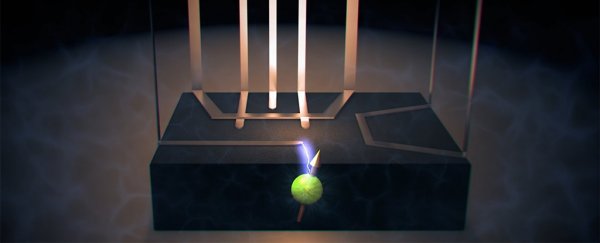Nearly 60 years ago, Nobel Prize-winning physicist Nicolaas Bloembergen predicted an exciting new phenomenon called nuclear electric resonance. But no one has been able to demonstrate it in action – until now.
Actual evidence of nuclear electric resonance has now been discovered by accident in a lab at the University of New South Wales (UNSW) in Australia, thanks to faulty equipment. The breakthrough gives scientists a new level of control over nuclei, and could seriously speed up the development of quantum computers.
Central to the phenomenon is the idea of controlling the spin of individual atoms using electrical rather than magnetic fields. That means more precise and more miniaturised management of nuclei, which could have profound impacts in a variety of fields.
"This discovery means that we now have a pathway to build quantum computers using single-atom spins without the need for any oscillating magnetic field for their operation," says quantum physicist Andrea Morello, from UNSW.
"Moreover, we can use these nuclei as exquisitely precise sensors of electric and magnetic fields, or to answer fundamental questions in quantum science."
In some situations, nuclear electric resonance has the potential to replace nuclear magnetic resonance, which is widely used today for a variety of purposes: for scanning human bodies, chemical elements, rock formations, and more.
The problem with the magnetic option is that it requires powerful currents, big coils, and a substantial amount of space – think about the size of an fMRI scanner at your local hospital, for example.
Not only that, in some ways it's a bit of a blunt instrument too. If you want to control individual atomic nuclei – for quantum computing, perhaps, or very small sensors – then nuclear magnetic resonance isn't a very good tool for the job.
"Performing magnetic resonance is like trying to move a particular ball on a billiard table by lifting and shaking the whole table," says Morello. "We'll move the intended ball, but we'll also move all the others."
"The breakthrough of electric resonance is like being handed an actual billiards stick to hit the ball exactly where you want it."
It was during a nuclear magnetic resonance experiment that the UNSW researchers cracked the puzzle set by Bloembergen in 1961, and it was all down to a broken antenna. After some head-scratching over unexpected results, the researchers realised their equipment was faulty – and demonstrating nuclear electric resonance.
With subsequent computer modelling, the team was able to show that the electrical fields could influence a nucleus at a fundamental level, distorting the atomic bonds around the nucleus and causing it to reorient itself.
Now that scientists know how nuclear electric resonance can work, they can research new ways to apply it. What's more, we can add this to the growing list of significant scientific discoveries that have been made by accident.
"This landmark result will open up a treasure trove of discoveries and applications," says Morello. "The system we created has enough complexity to study how the classical world we experience every day emerges from the quantum realm."
"Moreover, we can use its quantum complexity to build sensors of electromagnetic fields with vastly improved sensitivity. And all this, in a simple electronic device made in silicon, controlled with small voltages applied to a metal electrode."
The research has been published in Nature.
